The other day, I looked at the biometric data captured by my WHOOP strap back in early 2019, which was shortly after I started using the device to track my fitness and sleep.
One thing I noticed was that my average heart rate variability (HRV) was about 20 milliseconds lower than it is today. In other words, I’ve seen a significant improvement in HRV in only a few years, despite getting older. (HRV naturally declines with age.)
As a result of this discovery, I decided to analyze the lifestyle changes and performance tweaks I’ve implemented since 2019 to try and identify the ones that have most likely contributed to my increase in HRV.
In this article, I’ll share my findings and list the top 14 hacks I’ve used to increase my HRV.
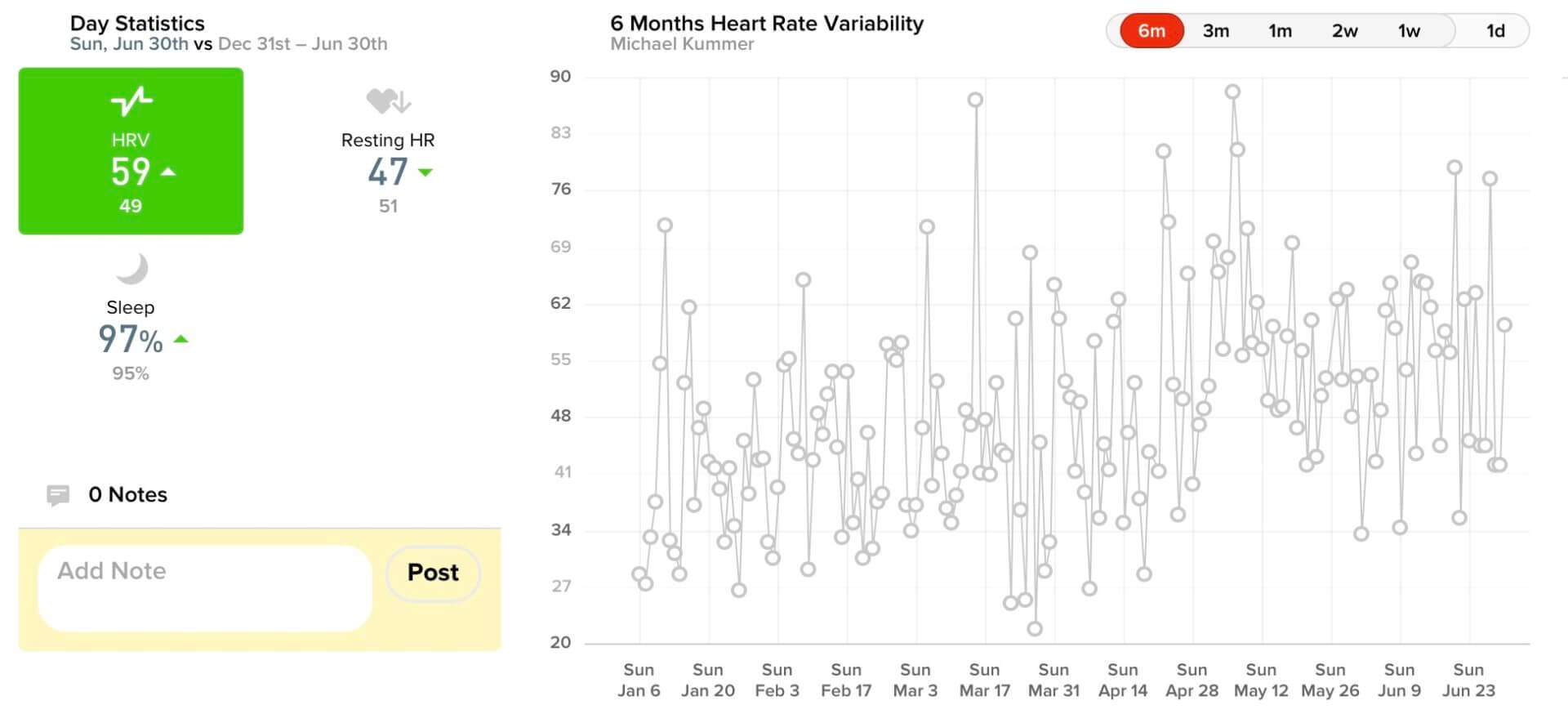

Before we get into the weeds, let’s talk about a few fundamental things, including:
- What is HRV?
- Why is HRV important?
- How can you measure HRV?
- How does your HRV change as you age?
- Why shouldn’t you compare your HRV to someone else’s?
- Why you might see an even greater improvement than I did from implementing the tips below.
If you’re already familiar with the concept of HRV, you can jump directly to the list of 14 HRV hacking tips. And if you’d prefer to watch the video version of this article, check it out on YouTube.
Heart Rate Variability: What You Need to Know
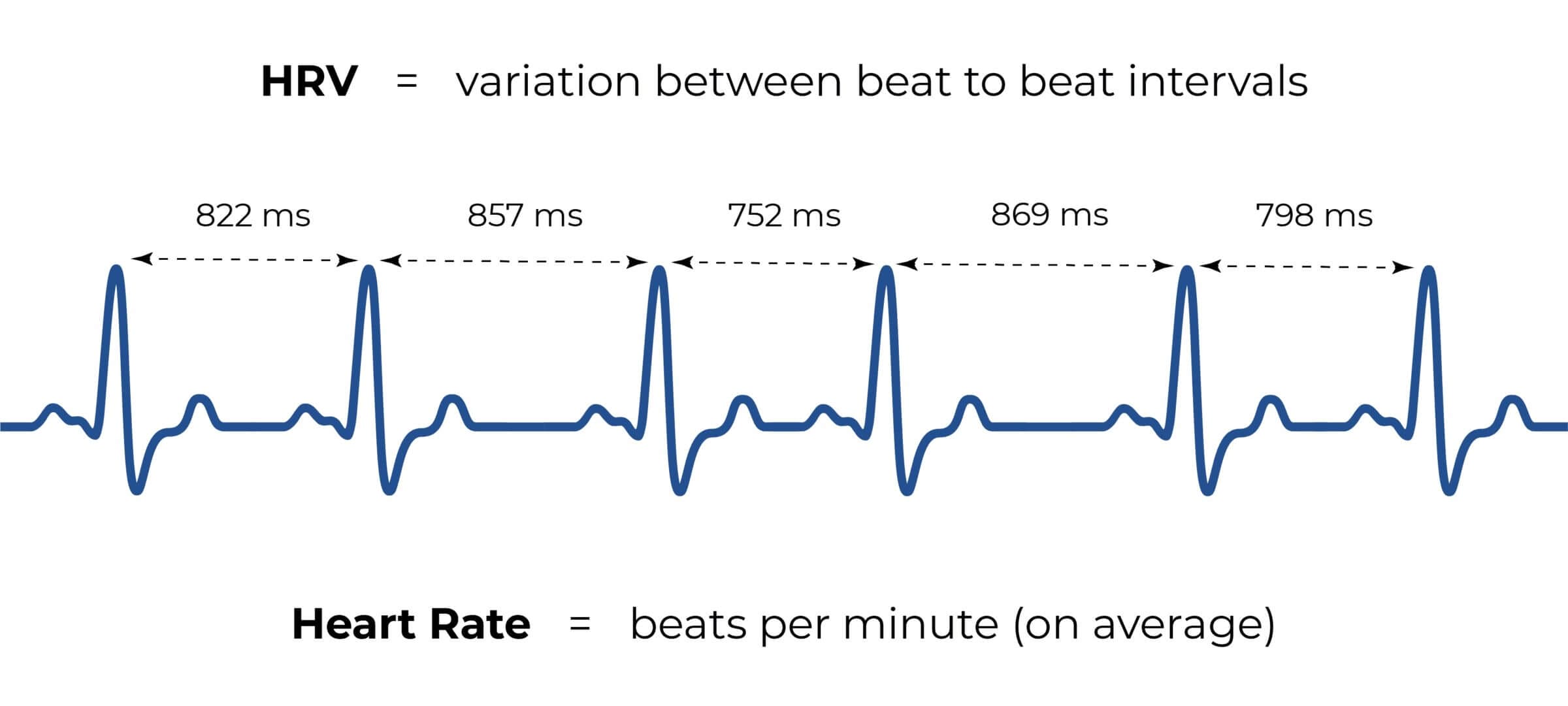
Heart rate variability is the difference in timing between heartbeats (also known as RR intervals).
For example, let’s say your heart beats at a rate of 60 times per minute. Although there are 60 seconds in a minute, your heart doesn’t necessarily beat exactly once per second — there’s a slight variation in that timing, which is expressed in milliseconds.
That variation in timing is called HRV.
Why Is HRV Important?
Measuring HRV is important because it gives you an indication of how your autonomic nervous system is doing. More specifically, it’s a reflection of your cardiac vagal tone, telling you how balanced your nervous system’s sympathetic and parasympathetic branches are.
The autonomic nervous system regulates certain body processes, such as blood pressure and the rate of breathing. This system works automatically (autonomously), without a person’s conscious effort.
It’s normal for these two branches to be in constant competition with each other; that’s what causes the differences in timing between heart beats.
Think of it like a game of tug of war: the more balanced this competition is, the higher your HRV is. But if one side is overly active, you can see a decline in HRV.
That’s important because the sympathetic branch of your nervous system is responsible for your fight or flight response (i.e., your stress response), whereas the parasympathetic branch is responsible for resting and digesting.
As such, a low HRV can be a sign that your body is spending too much time in a heightened state of stress. And while such a response is normal and useful when (for example) you’re recovering from an intense workout, it can cause health issues if it becomes chronic.
Because of this, it’s useful to keep tabs on your HRV so you can see trends and adjust your lifestyle, workout regime and stress management strategies accordingly.
How HRV Is Related to Fitness
Your heart rate variability does not directly reflect your level of fitness. In other words, the fact that someone has a higher HRV than you doesn’t necessarily mean they’re fitter than you.
However, if your HRV is low (compared to your baseline) when you’re not actively engaged in a sympathetic activity (such as a strenuous workout or parachuting out of an airplane), it’s a sign that your body is working hard for some other reason, such as fatigue, illness, stress or overtraining. And if that’s the case, you’ll likely have fewer resources at your disposal to crush your next workout.
Another crucial aspect of interpreting your HRV data is that most gadgets measure the root mean square of successive differences between normal heartbeats (RMSSD) by first calculating each successive time difference between heartbeats in milliseconds. Then, each of the values is squared and the result is averaged before the square root of the total is obtained.
Most people think that an RMSSD reading of 200 ms is twice as good as one of 100 ms. But that’s not correct, because RMSSD is a geometric scale, as Roy Dalle Vedove of hrvhealth.org pointed out in a comment on this article. So an HRV of 200 ms is only about 15% better than an HRV of 100 ms.
Dalle Vedove further explained that:
“A higher RMSSD figure is not always good. A person with a heart condition will have a very high figure, often in excess of 300. There are signals within the data that indicate when the person has a heart condition, and this is evident in the Poincaré plot, which is a graph that displays the regularity of the variation in the inter-beat intervals (IBI).
For example, someone with a pulse rate of 60 beats per minute might have an IBI that goes from 900 ms – 1100 ms – 900 ms – 1100 ms, or from 850 ms – 1050 ms – 950 ms – 1150 ms. The former is metronomic, and ideal. The latter, less so. Ideally, the Poincaré plot, when viewed, should be cigar-shaped. When it is circular, there is an issue.
This is where it starts to get interesting. Athletes who cycle will often have higher HRV numbers than CrossFit athletes or bodybuilders, but the Poincaré plot of cyclists is frequently not great looking, and certainly not as good as those of people whose exercise does not put the same degree of stress on the heart.”
— Roy Dalle Vedove
The point is that you shouldn’t get discouraged if your HRV hovers around 50 ms while your buddy’s averages around 80 ms, because the absolute difference between those two readings is only a few percentage points.
How and When Should You Measure HRV?
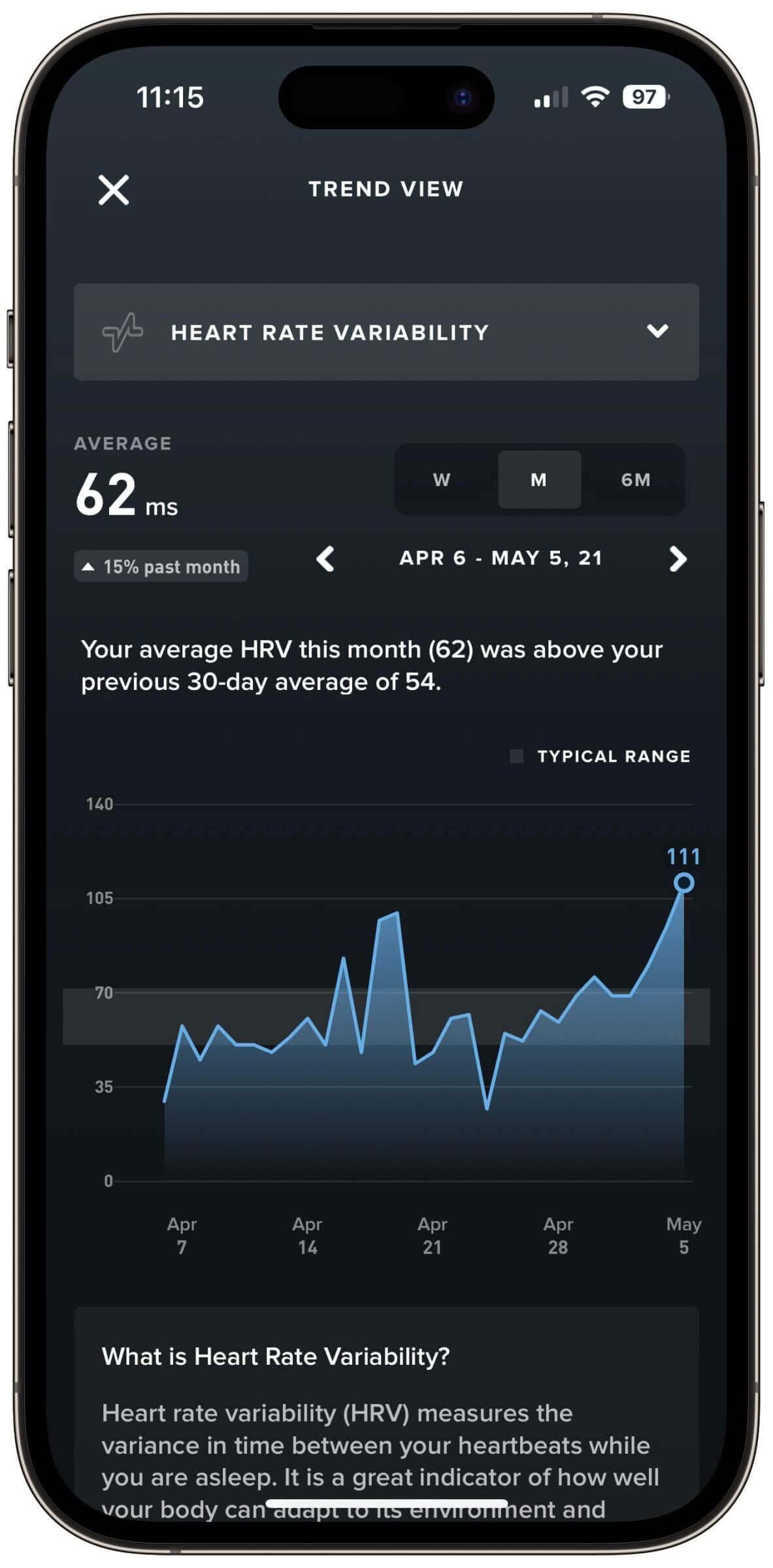
HRV is a highly volatile metric that constantly changes based on external influences. That’s why it only makes sense to measure it for analytical purposes in a controlled environment with minimal distractions and a heart rate that is close to your resting heart rate. That’s why WHOOP measures HRV during deep sleep to calculate a recovery score each morning. Being in deep sleep ensures that there are no influencing factors involved.
I use my WHOOP strap as well as my Pod Pro by Eight Sleep (a temperature-controlled smart mattress) to keep tabs on my HRV trends. By doing so every night, I can see changes in my HRV over time and correlate those changes with lifestyle factors to see what’s working and what isn’t.
If you don’t have an accurate sleep tracker to measure HRV, you can use a high-quality chest strap (such as the Polar H10) and apps like HRV Health to measure your HRV first thing in the morning.
What Is a Normal Heart Rate Variability?
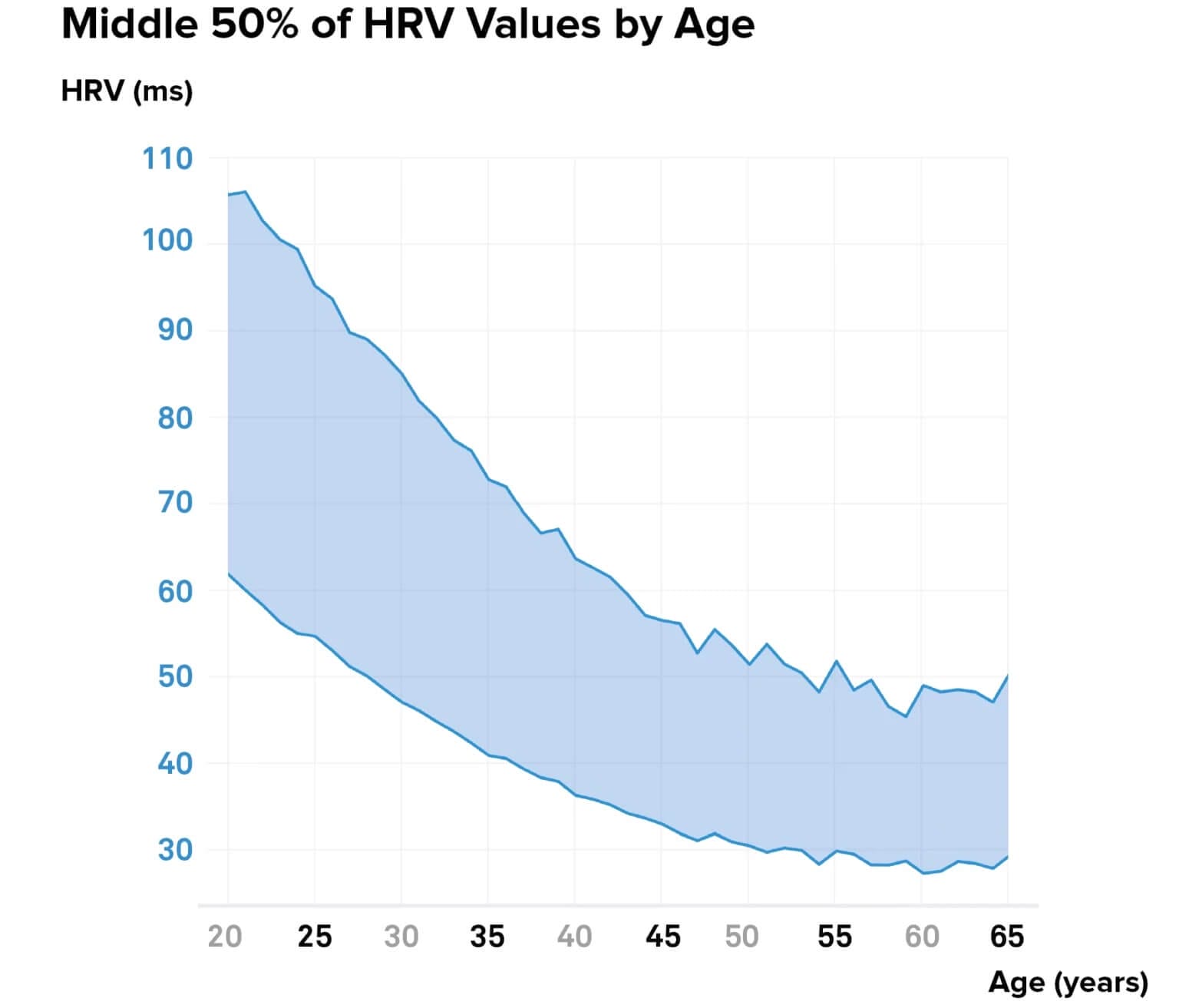
I’m very competitive. And if you are too, it’s all too easy to start comparing your HRV data with other people’s.
Don’t do that!
HRV is a highly personal metric that’s influenced by age (the older you get, the lower your HRV will be), genetic factors and lifestyle choices.
For example, some of the younger athletes at my CrossFit box have HRV readings of above 200. But they’re 20 years younger than I am, and I’ll probably never have that high of an HRV, just because of my age. (For reference, an HRV of 200 would be considered an outlier, similar to a resting heart rate of 40.)
The purpose of this article is to help you improve your HRV compared to your baseline, not compared to someone else’s baseline. In other words, monitor your HRV trend over time. If you see a positive trend, you’re on the right track.
It’s also worth noting that I had already implemented many of the tips I’m sharing with you in this article long before I started measuring my HRV. So chances are that my HRV used to be lower a few years ago when I was on a Standard American Diet, didn’t protect my sleep the way I do now, and didn’t exercise regularly.
I’m telling you this because I’m convinced that if you haven’t already implemented most of the tips from this article, you might see even greater improvements than I have.
With that said, let’s get to the 13 tips!
14 Lifestyle Hacks I’ve Used to Increase My Heart Rate Variability
While the list below isn’t in any particular order as far as priority is concerned, I recommend practicing most of them on a daily basis, if possible.
1. Follow a Species-Appropriate Diet

Humans evolved on a predominantly animal-based diet, and I’ve been experimenting with various versions of that, including paleo, ketogenic and carnivore diets.
After a few years of trial and error, I discovered that I perform best with an animal-based diet that’s centered around a nose-to-tail approach to food and complemented with seasonal fruits, raw honey and some of the least-toxic vegetables.
Despite having been on a very low-carb ketogenic diet for over two years, I’ve discovered that consuming more carbs than I had in the past would lead to an increase in HRV by 3 milliseconds (on average).

As a result, I recommend getting most of your calories from muscle and organ meat of pasture-raised animals because these are excellent sources of healthy fats, high-quality proteins and bio-available micronutrients, including vitamins and minerals.
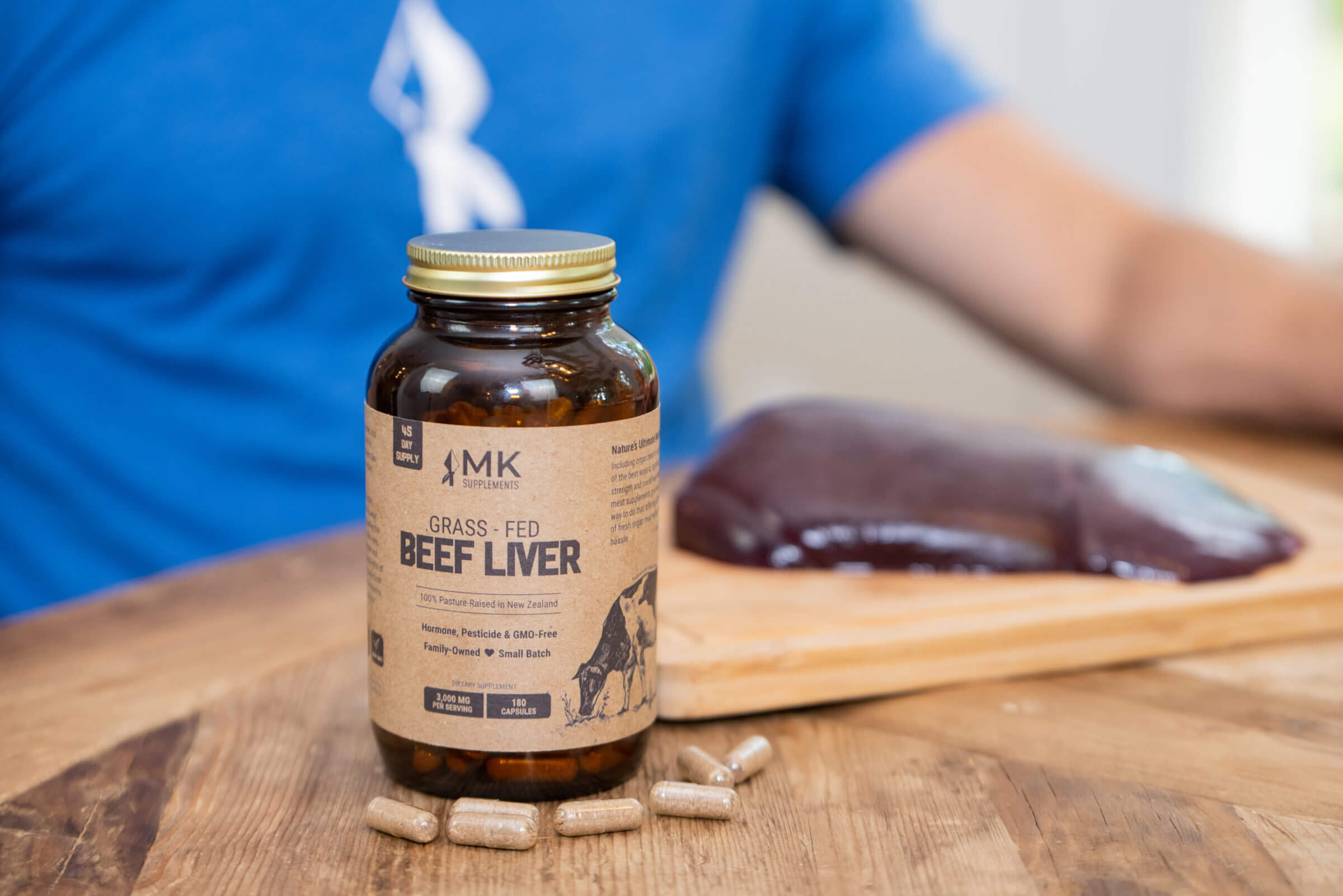
Organ meats are a particularly rich source of nutrients, which is why I highly recommend making them a regular part of your diet. You can learn more about the benefits of consuming organ meat in this article. However, if you can’t stomach the thought of eating fresh organs, I encourage you to supplement with freeze-dried organs instead.

But it’s not only important what you eat — meal timing plays a crucial role as well. For example, I’ve noticed that having late meals (within one to two hours of bedtime) decreases my HRV by an average of 10 milliseconds.
That’s why I recommend leaving at least three hours between your last meal and your bedtime: doing so gives your body ample time to digest the food, setting your body up to perform optimally — which will be reflected in your HRV.
If you’re not sure exactly which animal-based dietary framework to follow, you can read my article on the difference between paleo, keto and carnivore, as well as my article about the specific animal-based framework I adhere to.
2. Make Sure You Stay Hydrated

Everyone knows that staying hydrated is important for the body to function optimally. However, hydration becomes even more important if you follow a low-carb diet, such as a ketogenic diet.
That’s because when you don’t consume a lot of carbs your insulin levels remain low and your body will continuously access its glycogen stores as a source of glucose. Both factors lead to increased urination, and every time you pee you flush out electrolytes such as sodium, magnesium, potassium and calcium.
In turn, that can lead to an electrolyte imbalance.
To prevent this, I recommend drinking enough water and to consider leveraging an electrolyte supplement (such as LMNT, which is the one I use).
To judge whether or not you’re well-hydrated, just look at your urine. If it’s clear or pale yellow, you’re in good shape. If it’s dark yellow, you need to drink more water. If it’s brown, you’re having kidney issues and should see a doctor.
However, while drinking enough water is critical, drinking more water than your body needs can be counter-productive. If you overdrink, you’ll pee more often and thus flush out more electrolytes. So don’t overdo it!
Based on my WHOOP data, I’ve noticed that on days when I hydrate appropriately, my HRV increases by an average of 12 milliseconds.
3. Manage Your Alcohol Intake

It shouldn’t really come as a surprise that consuming alcohol lowers your HRV. In my case, just a glass or two of red wine in the evening lowers my HRV by 14 milliseconds.
On the rare occasions when I indulge in a third glass of wine, my HRV tanks significantly.
So the bottom line is that consuming alcohol negatively impacts your parasympathetic nervous system, and that results in a lower HRV.
On a side note, consuming alcohol doesn’t help with sleep. While it might make you sleepy, it actually decreases the quality of your sleep by disrupting your deep (REM) sleep.
It’s also worth noting that the consumption of alcohol might actually impact your HRV for four to five days, based on data from WHOOP members. That’s significant because it means you can permanently lower your HRV by drinking once or twice a week.
4. Expose Yourself to Sunlight Every Day

Sunlight has a significant impact on your circadian rhythm and overall well-being. It enables the body to make certain vitamins (such as vitamin D), and it influences the release of hormones, including cortisol in the morning and melatonin in the evening.
I recommend exposing yourself to sunlight in the morning, during the day and in the evening, because the sun radiates light in different frequencies throughout the day.
For example, the frequencies of sunlight in the morning help our bodies to get going, the frequencies during the day help with the production of vitamin D, and the frequencies in the evening help the body to wind down and start producing sleep-inducing hormones.
By keeping your body in sync with natural light, you support all of the chemical processes that are going on inside it. And doing so will be reflected in your HRV.
5. Support Your Circadian Rhythm
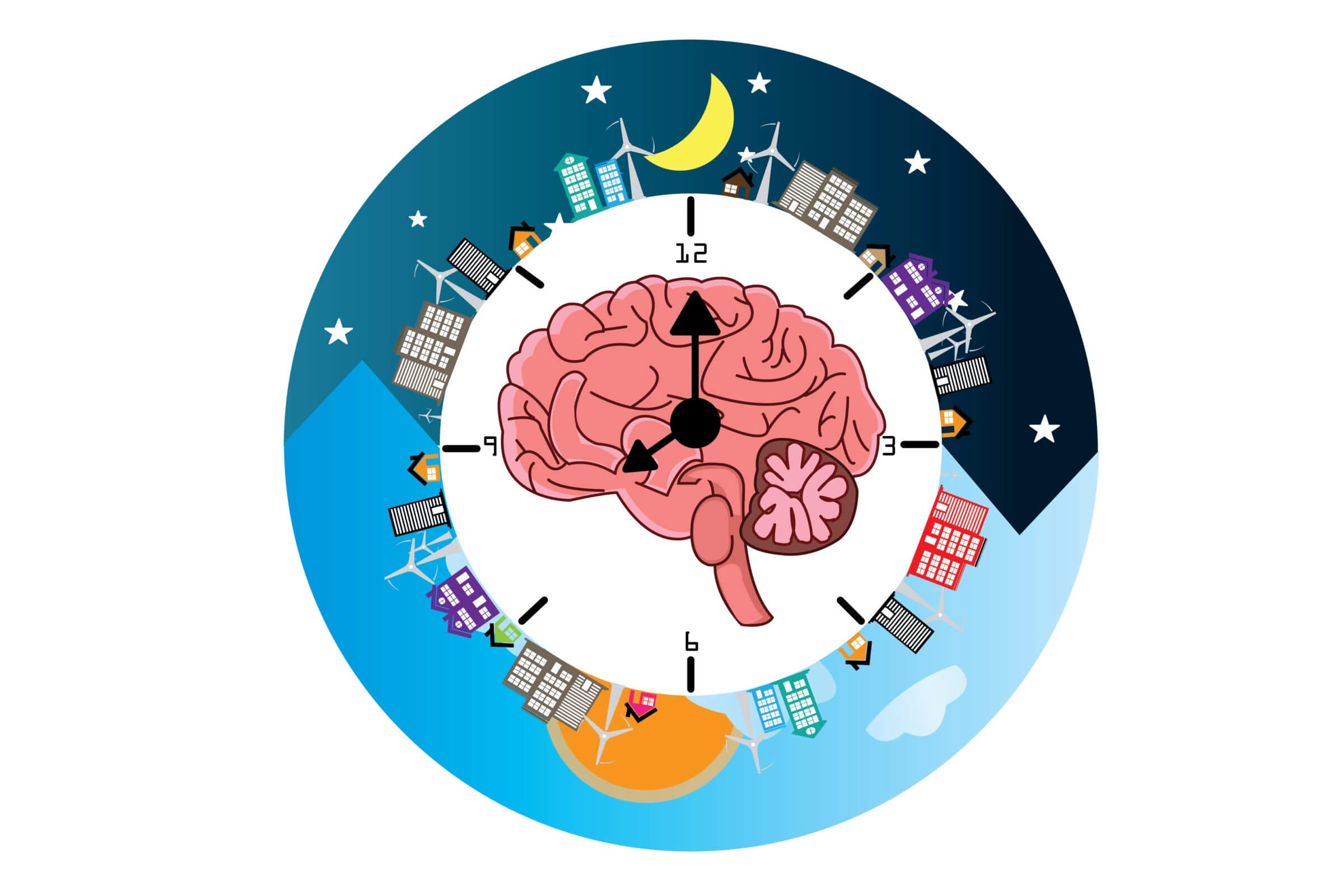
Closely related to #4 is your circadian rhythm — an internal clock that every cell in your body follows. By supporting this natural rhythm instead of getting in the way of it, you can help your body to perform optimally.
I’ve noticed that maintaining a consistent bed and wake time not only improves the quality of my sleep and my performance during the day, but also supports my parasympathetic nervous system, which results in an increased HRV score.
Also, as I mentioned above, don’t consume food too close to bedtime or after sunset.
If you follow these rules, you can optimally support your circadian rhythm and you’ll reap the benefits by having more energy during the day and a higher HRV.
6. Protect Your Sleep
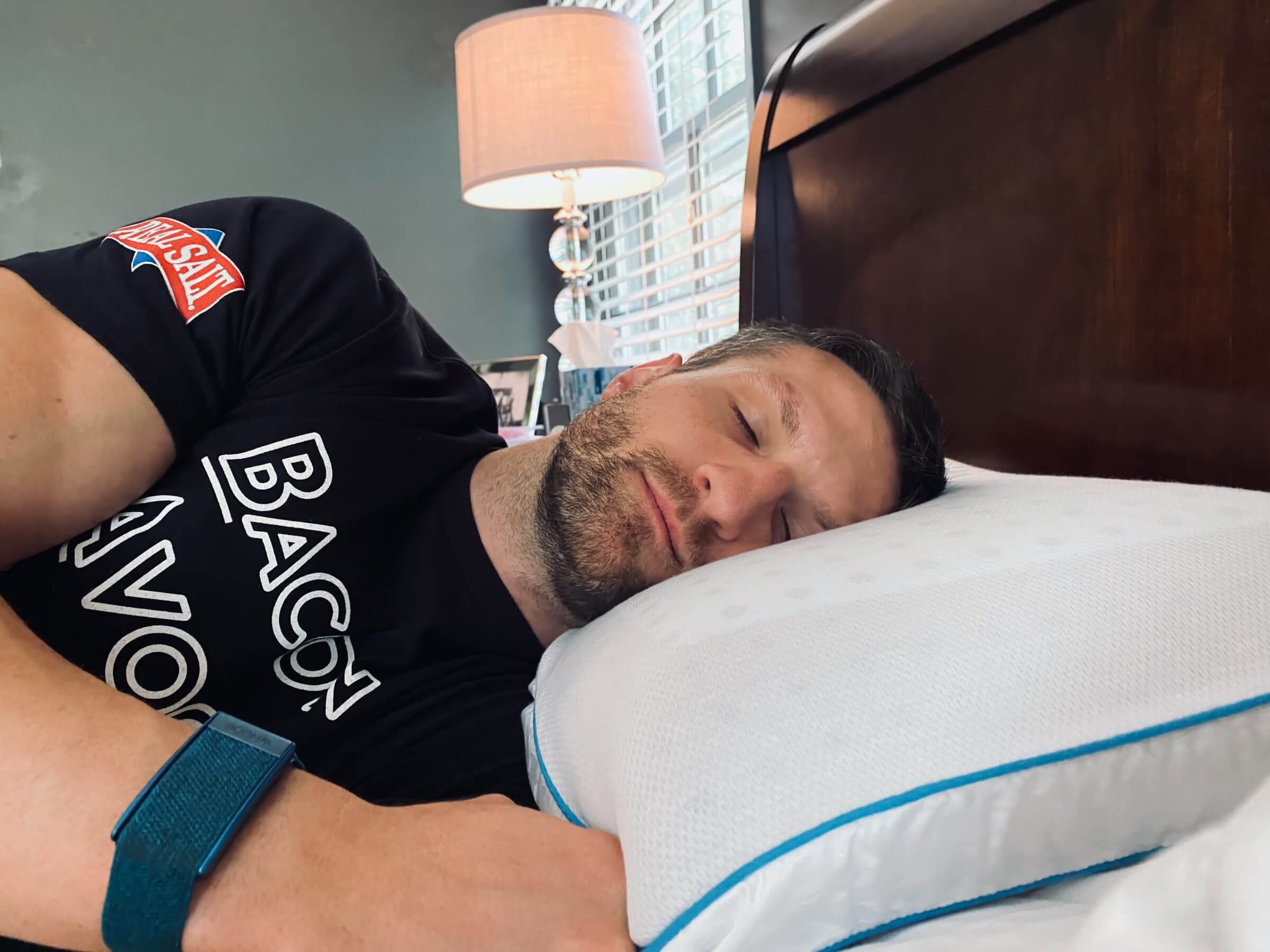
I consider sleep the foundation of a healthy lifestyle, and I’ve noticed that the more restorative sleep I get, the higher my HRV gets over time.
Deep sleep is particularly important because it helps the body recover physically from the stressors (like high-intensity exercise) you were exposed to during the day.
Additionally, I’ve seen great improvements in my HRV and sleep quality overall by better controlling the ambient temperature at night.
That’s because your body’s core temperature changes several times throughout the night, and the more you can do to support these temperature changes, the better your sleep will be — and the higher your chances are of increasing your HRV.
A few months ago, my wife and I got a temperature-controlled smart mattress, the Pod Pro by Eight Sleep (read my full Pod Pro review). The Pod Pro allows us to have a different temperature setting for each of the stages of sleep, including bed time, deep sleep, REM sleep and wake-up time.
Since then, we both have experienced a dramatic increase in sleep quality. We feel subjectively better in the morning, and our HRV has improved as well.
That’s when I realized how important it is to control the temperature (both in the bedroom as well as under the sheets).
7. Manage Mental Stress

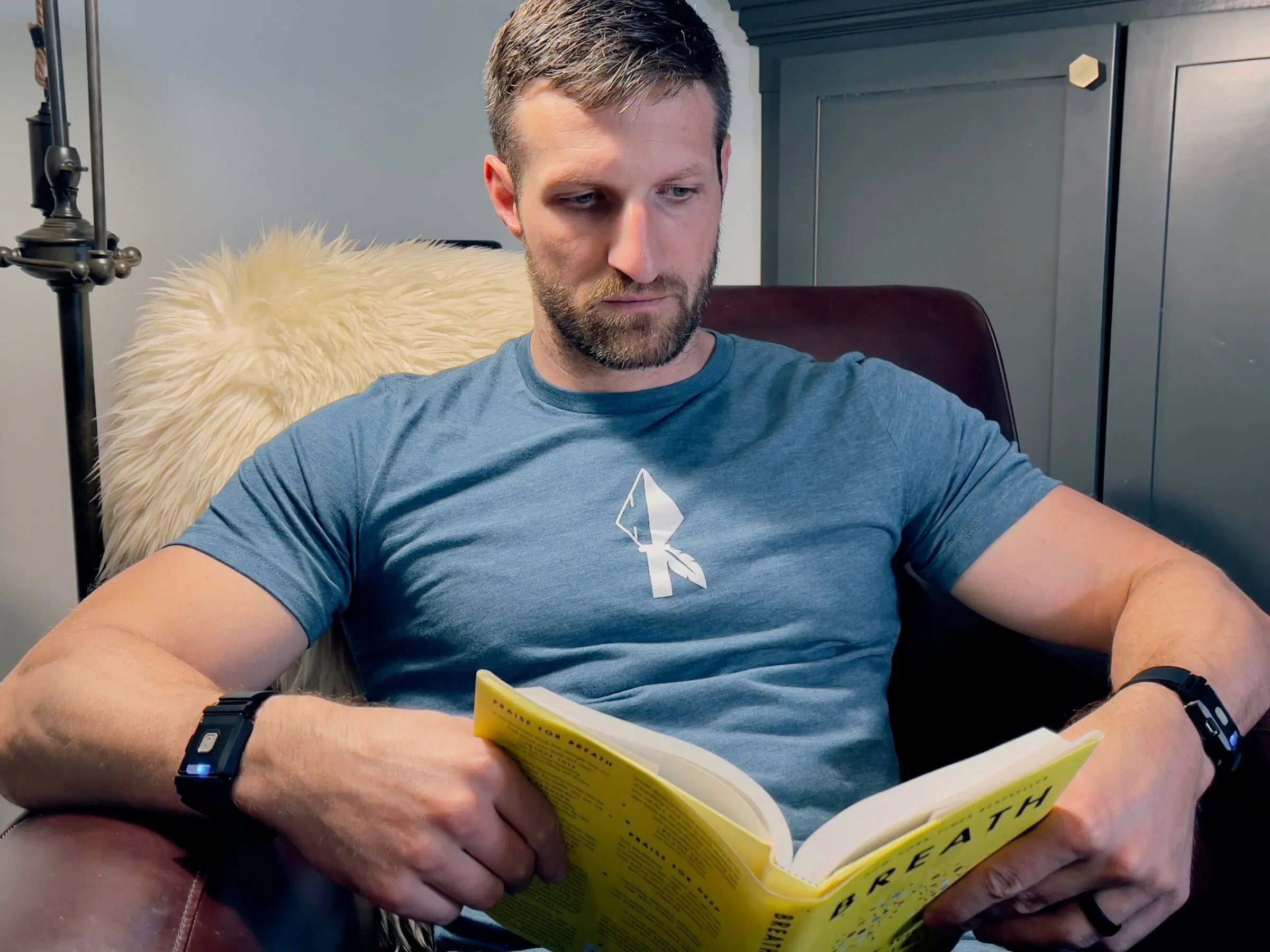
Considering that there’s an entire branch of the autonomic nervous system dedicated to responding to stress, it shouldn’t come as a surprise that stress has a major influence on your HRV.
For example, I’ve noticed that on days when I do everything right in terms of nutrition, hydration and sleep, I might still wake up with a lower-than-expected HRV if I was stressed out the day before.
Another good example is my wife, who always experiences a drop in HRV right before traveling. That’s because she gets stressed by all the things she has to take care of before a trip.
The good news is there are ways you can better manage stress to lessen its impact on your HRV.
A few of the techniques that have worked for me include:
- Deep breathing.
- Brain dumping my thoughts instead of letting them clutter up my brain.
- Tactile stimulation. (See my reviews of Apollo Neuro and TouchPoints for more information.)
- Reconnecting with nature (see below).
I’ve also recently started experimenting with CalmiGo, a deep breathing device that combines breathing with scents and other stimuli to help you calm down.
You can learn more about CalmiGo (and the other devices I mentioned above) in my roundup of the best gadgets for stress relief.
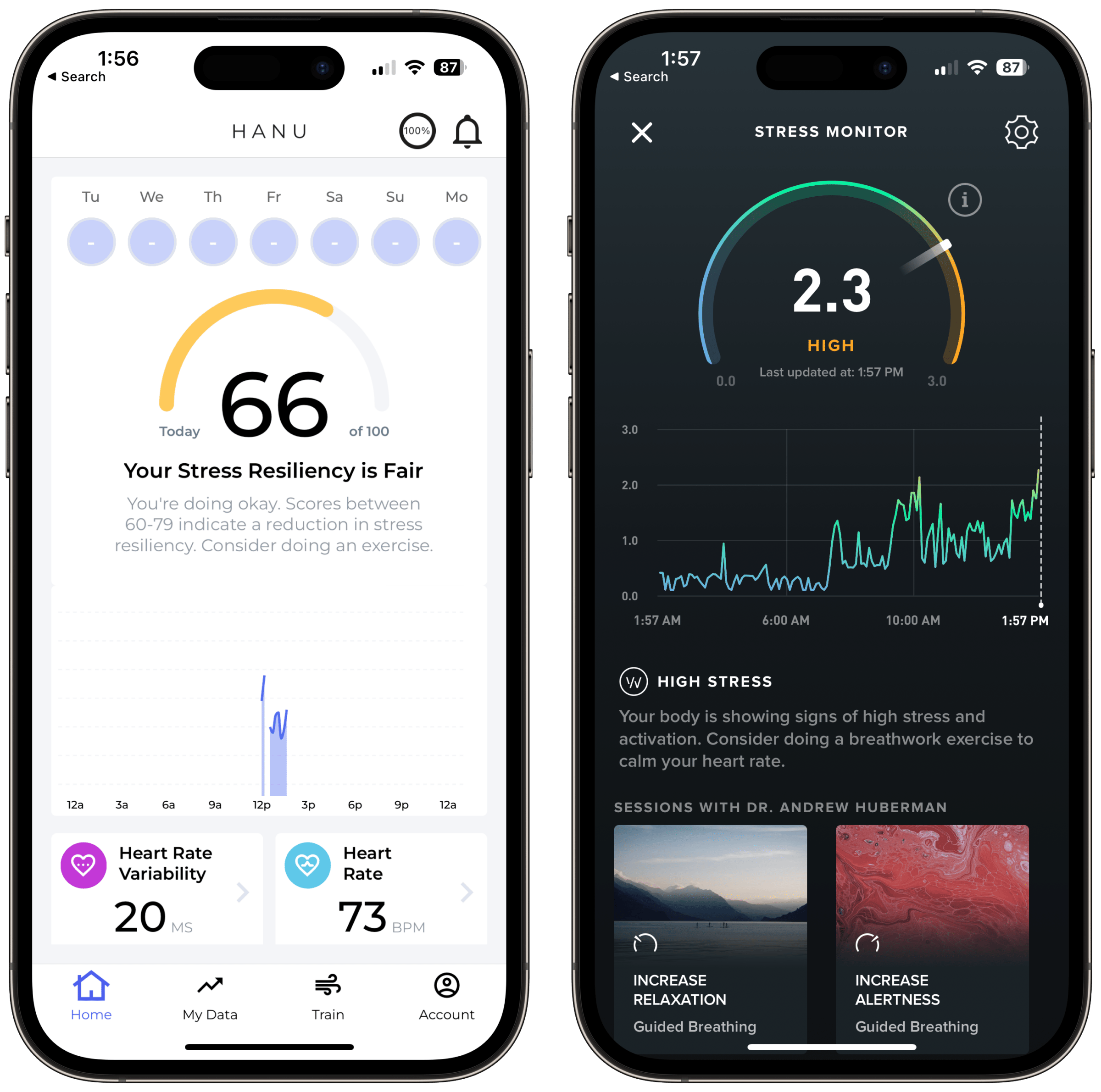
Another interesting tool I’ve stumbled across is HANU. It’s an app paired with a chest strap heart rate monitor (e.g., a Polar H10) to monitor your heart rate and HRV in real time. The app also sends you notifications when it detects rising stress levels and suggests counter-measures, such as breathing exercises.
WHOOP also recently added a stress monitor to its mobile app, which provides real-time insights and notifications if your stress levels spike. The app includes a curated library of guided breathing exercises that the company developed with famed neuroscientist Dr. Andrew Huberman.
8. Reconnect With Nature
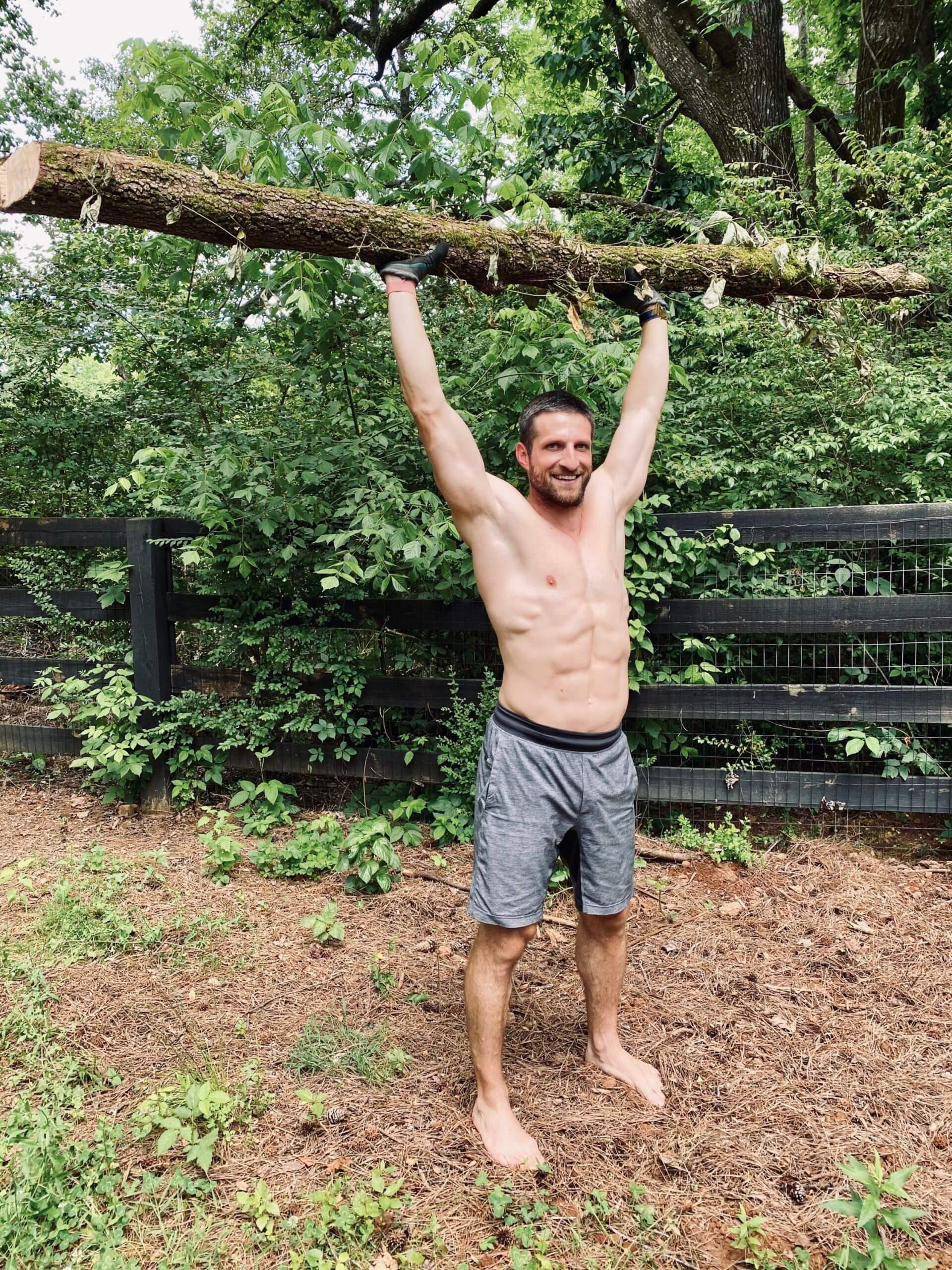

Much like consuming an animal-based diet, humans have evolved by being in close contact with nature.
I’ve discovered that spending time outdoors and being in close contact with plants, animals and the soil has a positive effect on my overall well-being and my ability to handle stress. As a result, my body has become more resilient and able to better handle stress.
For me, reconnecting with nature means taking my shoes, socks and shirt off (we have neighbors, so my pants have to stay on) and spending time in my backyard, sitting in the grass, interacting with our chickens or watching our bees collect nectar and pollen.
In fact, I just returned from cuddling our rooster Cacique because I needed a break from writing. Just 20 minutes outside gave me the energy and mental calmness to continue writing this article.
9. Exercise Vigorously and Lift Heavy
While strenuous physical activity is a stressor, it helps the body to repair, adapt and come out stronger on the other side. That adaptation is what improves your response to physical stimuli, leading to an increased HRV.
In fact, studies have shown that regular exercise is one of the best ways to improve your heart rate variability.
While there are different types of workout regimens, I suggest you do what our ancestors did throughout human evolution, including:
- Walk long distances.
- Partake in high-intensity workouts, such as CrossFit (unless you want to keep it real and fight a wild animal instead).
- Lift heavy weights.
All of these options reflect how humans have conditioned themselves over millions of years. And they’re the best ways to improve your HRV.
10. Practice Intermittent Fasting

Among all of the hacks above, intermittent fasting has had the most profound impact on my HRV. When you fast for extended periods, your body goes into preservation mode and starts executing ancient cell maintenance programs, such as autophagy.
By doing so, the parasympathetic nervous system becomes temporarily more active, leading to an increase in HRV.
While some of the crazy spikes in HRV I’ve seen during my 24 to 48-hour fasts are temporary, incorporating shorter intermittent fasts into your lifestyle can improve your health and lead to meaningful increases in HRV.
Much as with overtraining, you can overdo fasting, weakening your body and leading to a lower HRV.
If you want to learn more about fasting and its benefits, check out my ultimate guide on intermittent fasting. If you’ve tried it but struggled with discomfort, read this guide on how to curb your hunger while fasting.
11. Expose Your Body to Cold Water
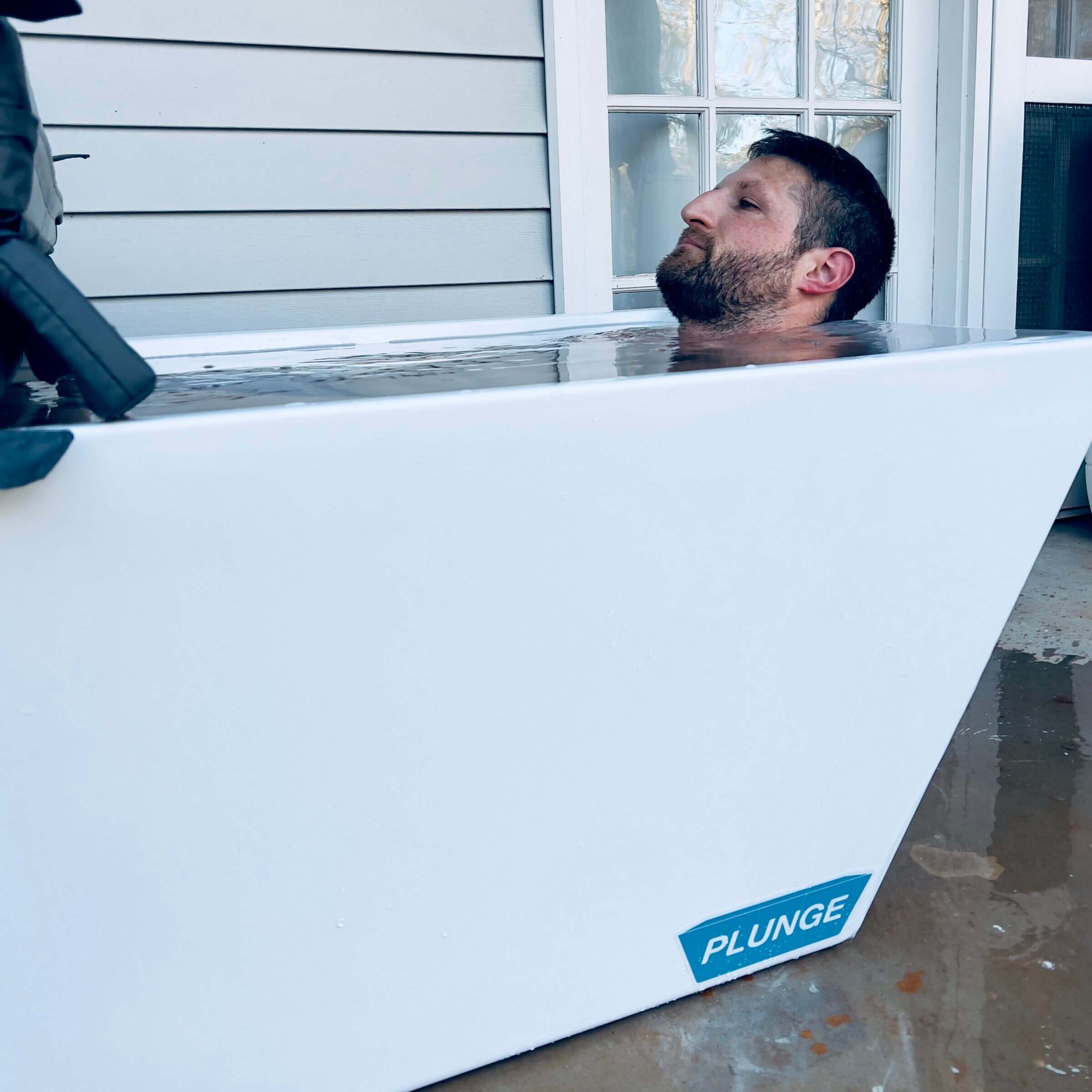
I recently discovered the many benefits of cold plunging, and I even purchased a cold plunge tub so I could expose my body to freezing cold temperatures several times a week.
The reason why cold plunging can help increase your HRV is because jumping into a tub filled with cold water up-regulates your sympathetic nervous system.
In other words, your body goes into a fight or flight response.
But as you learn to control your initial panic reaction in the water, you’ll also be able to apply the same calming techniques in other everyday situations. In essence, cold plunging teaches you to better manage stress, which can suppress your parasympathetic response and thus increase your HRV.
There are good cold plunges available for any budget, including an inflatable one the costs just $150. But if you’re not quite ready for cold plunging, start by taking cold showers every day!
12. Breathe Intentionally
One of the best ways to directly influence your central nervous system is through intentional breathing, which can both up-regulate and down-regulate the sympathetic and parasympathetic branches of your nervous system.
For example, I use a box-breathing technique while I’m in the cold plunge, and a fast-paced breathing pattern (called fire breathing) before workouts or when I feel low on energy. So depending on how I want to influence my nervous system, I use different breathing patterns and lengths.
One of the best tools I’ve found for learning about different breathing techniques is an app called Othership, which helps you discover different (guided) breathing techniques based on what you’re trying to accomplish. There are hundreds of sessions and journeys, and you can filter them based on the type of breath work you’re looking for, session lengths, your goals and other criteria.
For example, there are dozens of breath work exercises that are meant to relax you before bedtime and help you fall asleep quicker.
If you’re not breathing with intention yet, I highly recommend you give it a try and see how it impacts your HRV.
13. Meditate

Meditation is another excellent tool to help you better manage stress and keep the sympathetic branch of your nervous system in check when it’s not needed. (That, in turn, allows the parasympathetic branch to be more active, resulting in an increased HRV).
I’ve been using mindfulness and meditation as a way to improve my overall health and well-being, with the support of Muse S (a brain-sending headband).
14. Leverage the Power of Ketones
There is scientific evidence that suggests that a very low-calorie ketogenic diet can increase heart rate variability.
While I haven’t tested this, I have noticed improvements in sleep quality and elevated HRV readings when I consume exogenous ketones (i.e., ketone supplements, such as the SnakeWater healthy energy drink pictured above).
I suspect that the reason for elevated HRV readings after consuming exogenous ketones is that ketones can reduce oxidative stress and inflammation. Lower stress and inflammation can lead to muting of the sympathetic nervous system and thus higher HRV readings.
Here’s a list of the best exogenous ketone supplements if you want to give it a try.
Other Methods of Increasing HRV
The 14 hacks I mentioned in this article are the ones I’ve made part of my lifestyle. However, there are other methods that are also worth exploring, including gratitude journaling.
Based on data from WHOOP and independent studies, writing down what you’re grateful for can elicit a corresponding uptick in HRV. That’s another thing on my list to try!
If you’ve found any other hacks, tips or tricks that have improved your average HRV, let me know in the comments!
Frequently Asked Questions
Observational studies have shown that a low heart rate variability is associated with an increased risk of diabetes, high blood pressure (hypertension), and cardiovascular disease (CVD). While that doesn’t mean that a low HRV causes these issues, it might be an indication that certain lifestyle choices (alcohol consumption, poor diet, lack of sleep, etc.) play a role in increasing the risk factors for such health issues.
As a result, I recommend implementing most of the tips I’ve shared in this blog post, which I believe will help you reduce your risk factors and increase your HRV.
That depends on what your personal HRV potential (or HRV baseline) is. For me, anything above 70 milliseconds is good, because my current average is around 60 milliseconds. In other words, nobody can give you a generalized answer or a single number because HRV is such a personal metric.
However, familiarizing yourself with the average HRV by age and gender can be helpful for determining whether your HRV currently falls into a “normal” range.
Any type of regular exercise (aerobic and anaerobic) can lead to an increase in HRV. The important part is to train in a way that allows your body to recover in between training sessions. Using your HRV data as a guideline is an excellent way to ensure you’re getting the right balance of intensity and recovery.
Yes, there appears to be an inverse correlation between HRV and RHR. Personally, I’ve noticed that on days when my body is having a hard time responding to certain stressors, my HRV goes down while my RHR goes up.
HRV training accounts for changes in your HRV in order to better plan periods of rest and recovery. Studies have shown that you can effectively improve your cardiorespiratory fitness by using HRV for daily training prescription.
Yes, based on data and a study conducted by WHOOP, sudden changes in HRV can be a reliable indicator of preterm births. WHOOP analyzed the physiological data of 241 pregnancies and found that in singleton pregnancies, maternal heart rate variability (HRV) trends invert seven weeks prior to delivery. So if you’re currently pregnant or trying to become pregnant, I recommend signing up for WHOOP.
How to Improve HRV: Wrap-Up and Final Thoughts
Heart rate variability is a highly personal metric that depends on several factors including genetics and lifestyle. However, I’m convinced that the closer you get your body to its natural state (based on millions of years of human evolution), the more likely it’ll work optimally. And your heart rate variability will reflect that!
So I encourage you to experiment with the 14 hacks that have improved my HRV to see which ones have the most impact for you.
Of course, you can only improve what you can measure. So get yourself a wearable that can track HRV, such as the WHOOP strap, to see how the changes you implement affect your HRV.
If you do, let me know in the comments what has worked for you (and what hasn’t)!

Michael Kummer is a healthy living enthusiast and CrossFit athlete whose goal is to help people achieve optimal health by bridging the gap between ancestral living and the demands of modern society.
Medical Disclaimer
The information shared on this blog is for educational purposes only, is not a substitute for the advice of medical doctors or registered dieticians (which we are not) and should not be used to prevent, diagnose, or treat any condition. Consult with a physician before starting a fitness regimen, adding supplements to your diet, or making other changes that may affect your medications, treatment plan or overall health. MichaelKummer.com and its owner MK Media Group, LLC are not liable for how you use and implement the information shared here, which is based on the opinions of the authors formed after engaging in personal use and research. We recommend products, services, or programs and are sometimes compensated for doing so as affiliates. Please read our Terms and Conditions for further information, including our privacy policy.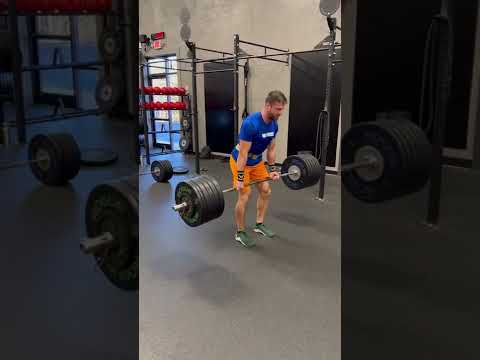


![How I've INCREASED my HRV by 50% [10 HACKS]](https://michaelkummer.com/wp-content/cache/flying-press/ribK92pL5Js-hqdefault.jpg)
I am 26 years old and quite active. I weight lift 3-4 times a week and do light to moderate cardio 3-4 times a week. Some days I do both, some days I offset. I follow a carnivore diet because I have a histamine intolerance and cannot tolerate plant matter. I’ve dealt with a variety health problems for 12 years, which started after I fell and bruised a lung. From that time on, I began vomiting every day sometimes 10 times a day. I went from a 140 lb strong equestrian (at 5’5″) to about 95 lbs in about 3 years. I was hospitalized with a feeding tube but that was a short term solution and it barely helps. All my problems came back so I ignored previously given dietary advice and started eating paleo, then keto, then more carnivore. I’ve improved with each but now, after several years of being carnivore and getting back to a much healthier 130-135 lbs, I still deal with many symptoms. We think my trauma from my fall and years of getting bucked off my horse damaged my vagus nerve and lungs which explains all of my symptoms: dysautonomia, Raynaud’s, paradoxical breathing, chest pain, heart palpitations, low blood pressure, fatigue, dizziness. I also have severe iron deficiency anemia. My average HRV is 22 and I genuinely don’t know how much I can actually improve it. I don’t drink or smoke and as I said, I am as active as I can be but I know I am not recovering well from my workouts. I just ordered the Apollo Neuro but that says it only improves HRV by 11%. I take cold showers but can’t afford to or have the space for the plunge set ups. If my vagus nerve is damaged and my HRV is this low, is it at all reasonable that I could get it up to normal?
Thank you for sharing your story—it sounds like you’ve been through an incredibly tough journey. Given everything you’ve dealt with, it’s impressive how much you’ve already improved through dietary and lifestyle changes. Regarding your HRV and vagus nerve damage, there is hope for improvement, though it may take time and a multifaceted approach.
First, keep in mind that HRV is influenced by many factors, including stress, recovery, sleep, and overall autonomic nervous system health. While tools like the Apollo Neuro and cold exposure can help, the key is consistency in supporting your parasympathetic nervous system. Improving HRV may be a slow process, but even small gains can make a difference in your overall health and recovery.
Here are a few additional strategies that might help:
1. Breathing exercises – Since you mentioned paradoxical breathing, focusing on diaphragmatic breathing can directly engage the vagus nerve and help restore proper breathing patterns. Breathwork practices like box breathing or the Buteyko method could be worth exploring.
2. HRV biofeedback – Some tools offer real-time feedback to help train your nervous system to improve HRV. While it’s an investment, it may be helpful in guiding your recovery process.
3. Light recovery work – Since you’re active, incorporating low-intensity activities like yoga, walking, or stretching into your routine can help stimulate the parasympathetic nervous system, supporting better recovery.
With the potential damage to your vagus nerve, it’s hard to say whether you’ll reach “normal” HRV levels, but focusing on recovery and nervous system balance could bring gradual improvement. Your body’s resilience has already proven itself with your progress so far, so there’s reason to be optimistic, even if the path ahead requires patience.
Let me know if you want to dive deeper into any of these topics, and best of luck with the Apollo Neuro!
Yeah really good article, Michael!
I have been trying to find a one-stop guide and improvement list for HRV. You’ve consolidated everything I’ve been looking for here!
Keep doing what ya doing!
Thanks! Chris
Thanks, Chris! I appreciate the feedback!
I really enjoyed your article as my doctors told me there was nothing I could do to improve my HRT which is low.This didnt seem logical my own logic told me that if I got fotter ate healthoer stayed more hydrated slept better this would help but now that I have read your article I’m even more determined to prove the doctors wrong and more importantly have a lot better health outcome for myself.It has given me the encouragement I needed to take this more seriously and follow the positive strategies you have outlined. Thankyou kindly for taking the time to write this wonderfull article.
Kind Regards Sharon Coyle
Thanks so much for your feedback! You can definitely influence your HRV with proper lifestyle choices!
Michael,
This is a fantastic post – thank you for all the info. I have used WHOOP for the past year and have always had a lower but average HRV for my age. High stress work environment, new baby, and some alcohol or cannabis consumption have been factors. I am now making a strong effort across the board – working out more, regular sleeping pattern, drinking lots of water, healthy diet / intermittent low carb, TM meditation every night, no toxins. It has only been 3 weeks but my HRV is persistently stuck in the low range — in fact I’ve had more yellow recoveries than ever before when I used to have at least 2-3 days a week with a higher HRV and green recovery. I suspect my body needs more time to adjust to a healthier lifestyle — is that your take? I don’t know what to do other than keep going and perhaps it will take months before my baseline improves? Thank you in advance!
Hey Ben!
You need to give it a couple of months to see improvements. However, if your stress levels remain elevated, you may not see dramatic improvements even if you do everything else right. Stress is, by definition, an HRV killer.
Great article, however I do have a question.
Would the following statement sometimes or always be an accurate statement?
When looking at exercise and recovery as a factor being used to improve my baseline HRV, as exercise frequency, duration and intensity are increased, it’s normal for HRV to rise acutely into an unbalanced state. However, over time, as adaption to the increase in exercise as well as improvements in recovery times and max and resting heart rates, the higher HRV measurements will no longer be unbalances as they merge into the improved HRV baseline.
Personally, I’m seeing an incremental increase week to week, in my HRV baseline while also leaving behind my previous unbalanced, higher, acute HRV measurements.
Hey Jason,
If you increase your workout volume, you’ll likely see a drop (not an increase) in HRV but over time, your body adapts and your HRV goes up (above baseline). I haven’t seen any spikes in HRV triggered by more intense workouts.
Cheers,
Michael
Your insights are helping me to wrap my head around HRV measurements, I think it seems odd to me since most other health measurements are based on higher numbers being unhealthy. I’ve only really started paying attention to this metric recently, but thankfully my watch has been recording HRV for almost two years.
On my Garmin, I do see the acute readings nose-dive after my HIT endurance hiking, but as I progress and adapt to the increased load, I’m spending less time in that unbalanced lowered HRV state and recovering faster. Now, looking at my longer trends, 4 week, 6 month, 1 year, I can see my HRV is trending higher, however very slowly.
I need to be patient, which I’m sure will increase time in a parasympathetic state, which as I understand will also help increase my HRV and overall health.
I did just added a Polar H10 and got the EliteHRV app, which I’ve already found to be motivating tools. I like that EliteHRV app also has breathing exercises I can integrate into my program.
Again thanks for taking the time Michael, much appreciated.
And folks, check out Michael’s YouTube Channel.
Thanks so much for the feedback, Jason! I much appreciate it!
Michael, You don’t have to post this but I just read this on Elite HRV, and wanted to share with you… which may shed some light on what I may have been experiencing regarding, linked to overtraining/not enough recovery time & spikes in HRV.
If you didn’t already write about this, perhaps you could rephrase it (to avoid copyright) and point out this anomaly that people may be experiencing.
Copied from EliteHRV:
(https://help.elitehrv.com/article/78-is-a-higher-hrv-always-better)
“Most folks understand that if your HRV drops a significant amount, it is indicating that you are likely experiencing abnormal amounts of stress (Sympathetic NS activity). It is then recommended to prioritize rest and recovery for optimal long-term results. However, it is less intuitive that the same can be said if your HRV rises a significant amount in a short period of time. If your HRV rises abnormally high (above a certain standard deviation) within a day or a few days, the app indicates with a yellow or red that you are likely experiencing abnormal amounts of recovery (Parasympathetic NS activity). This is often in response to accumulated amounts of stress.
Here are a few scenarios resulting in a high HRV score paired with a yellow or red readiness indicator:
Overtraining – Overreaching and over-training can occur when you repeatedly experience a level of stress that your body can’t recover from. This often registers as decreasing HRV over the course of a few days, followed by a sharp increase in HRV suddenly one day. This happens because, at a certain point, your body reaches a threshold where it has to stop prioritizing the fight or flight stress response and goes into a deep recovery.
Mild sickness
Change in exercise routine
Change in sleep patterns”
Hi Jason,
I never saw or hears of a lower recovery score (I assume the author is referring to WHOOP) after a sharp rise in HRV.
Michael,
Starting to feel bad dominating the comments but I wanted to share my experience with other readers, though I’m sure you’re already aware and have stated as much…
I was relying on my Garmin Fenix7 pro for my HRV readings (which occur during sleep). I’ve since got a Polar H10 paired with my EliteHRV app and my daily, morning readings now seem way more accurate based on my age, how I feel and my fitness level. I’m seeing an upward trend on my Garmin as well, just not as high as with the Polar. I’m going with the Polar for sure, much more motivating also, especially with the EliteHRV app, all the supporting information, the guided breathing exercises they offer, is really helping me become more parasympathetic dominant and not just dwelling on my score.
I may be repeating what you’ve already said, but if readers are not using a dedicated heart rate monitor and using a smart watch to track HRV, I wouldn’t get too down on your HRV scores until you’ve invested in a more accurate monitor.
Cheers Michael.
Excellent advice. I am the founder of HRV Health AG, a Swiss company using HRV to provide users with feedback as they benefit from adopting a healthy lifestyle.
We have the data from thousands of users that confirms the benefits of your suggestions.
Measuring HRV goes beyond rMSSD – the figure that is usually provided as the metric for HRV. RMSSD is a geometric scale, meaning that an HRV figure of 200 is not twice as good as one of 100 – it’s about 15% better.
A higher rMSSD figure is not always good. A person with a heart condition will have a very high figure, often in excess of 300. There are signals within the data that indicate when the person has a heart condition, and this is evident in the Poincaré plot – a graph that displays the regularity of the variation in the inter-beat intervals(IBI). For example, someone with a pulse rate of 60 beats per minute might have an IBI that goes from 900ms – 1100ms – 900ms – 1100ms….. or 850ms – 1050ms – 950ms – 1150ms…. The former is metronomic, and ideal. The latter, less so.
Ideally, the Poincaré plot when viewed should be cigar shaped. When it is circular, there is an issue.
This is where it start to get interesting. Athletes who cycle will often have higher HRV numbers than cross-fit or body builders – but the Poincaré plot of cyclists is frequently not great looking, and certainly not as good as those of people whose exercise does not put the same degree of stress on the heart.
HRV is measured in milliseconds, and so the equipment for measurement needs to be at that level of accuracy, using ECG rather than PPG. This is particularly significant for people who have low HRV numbers.
You have recommended taking HRV while sleeping because there are so many variables that impact the figures.
You are correct that the reading needs to be taken in a controlled way, and being asleep does not meet that criterion.
We advise our users take their readings as close to resting heart rate as possible, and then at the same time each day.
I congratulate you on covering this topic so well. I hope that everyone follows your excellent advice.
Thanks for the feedback Roy, that’s great information. I downloaded your app and will play around with it!
You’re welcome. Please be aware that the HRV Health apps only work with the Polar H9 and H10 heart rate monitors. If you want to take ECG readings, you will need the H10.
Once you start using the app, please feel free to contact me if you need any guidance. We have articles that provide guidance on best practice, how to interpret the results, and what you should read to get the best out of HRV.
Cheers,
Roy
Thank you so much. I am 80 yrs old. My heart rate is 52. I eat a very healthy diet and no alcohol. I am a meditator of 43 years combined with deep breathing techniques. Since reading you very important information on HRV I started to do intermitant fasting and my HRV went from 10 to 32 at night on my fitbit. My pulse went downl to 52 from 60 and I have much more enery I am so happy. Thank you very much.
You’re most welcome Florence!
64 year female- and my daytime Hrv runs between 15-35. However, for the last 2 weeks my hrv pattern at night and especially just before I wake up has increased. Last night between 1 am – 5 am -my Hrv went from 14 to 34 and at 5:00 am it increased to 95. I’ve been working toward reducing daily stress levels with breathing, regular sleeping hours, nature walks, as well as increasing positive social time m Should I be concerned about my 5:00am spike to 95 hrv reading? Also, what is the best time to determine my baseline HRV?
Hi Katherine!
The best time to measure HRV is during deep sleep because there are no external factors that could influence the reading. Spikes like the ones you’re describing are completely normal and no reason for concern.
Cheers,
Michael
Found your article when i searched how to increase HRV..
I’m in my late 30s n using fitbit to watch my HRV & resting heart rate.. Recently I drank 2.5 glasses of red wine n I noticed my HRV decreased from 89 to 22. .I used to exercise but I stopped and will be starting again.. I noticed pattern which is once every two weeks my HRV ll go low(lowest was 30s to 40s)… my question is even if I exercise and my HRV doesn’t increase , does it mean I have health issues??
Hi Kath,
No I don’t think a lack of increase is a sign of a health issue. Exercise is just one of the many factors that influence HRV.
Cheers,
Michael
51M new to HRV and sitting at 35ms, which looks like it is on the low side for my age despite being very fit and having a fairly sensible lifestyle. I found your article and wanted to say thanks for the really useful description of the HRV measure, and I appreciated all the tips on what influences it. I’ll be trying some of them out to see if I can improve…
You’re most welcome Charlie! Keep me posted how it goes!
I have to laugh at these comments because it seems that being a SAHM is prime conditions for low HRV. 🤣
I am in my early 40s, don’t drink, eat mostly paleo, exercise or be active every day, get 7-8 of sleep a night, connect with nature, do wim hof, sauna, cold showers, get sunlight, don’t eat before bed and I can never get my HRV above 40 at night, it’s usually in the 20s or 30s. I have seen a relationship between my RHR and my HRV but I wish I could figure out why it’s just so terrible at night. It goes between 30-80 during the day. I am just stumped why I can’t get it to improve, even with all the improvements I have made in my lifestyle the past 18m I have been following it.
Thanks for the article!
Hey Arissa,
My wife’s is in her 30s and has a lower HRV than I have even though she does most of the things I do to optimize it. Some of it is certainly genetics and it matters more how much you can improve your HRV compared to your baseline than to someone else’s.
Also, what device do you use to measure HRV and does it measure a single recording (i.e., WHOOP) or a nightly average (i.e., Eight Sleep)?
Last but not least, many of the things you do to improve your health are (positive) stressors but stressors nonetheless. If you deal with negative stress in your life (work, kids…) and pile on those positive stressors, it might be too much. I wrote about that in my last newsletter – see https://michaelkummer.com/subscribe/
Cheers,
Michael
Great article indeed, my HRV is middle for my age, but I have thyroid issues and that can really throw a fat wrench into my HRV in most cases.
I really need to diet better and like your approach, I have tried intermittent fasting but it’s tough on me because my job is mentally demanding and I lose weight focus.
One minor detail thou, humans have only been around for 300k years :)
Thanks for the feedback! Regarding “humans,” I meant humans and their ancestors :)
Thanks for the info! I had no idea what HRV was until I got my Oura ring (hubby got us both rings a few weeks ago). My HRV is really low, like ranges from 10-13 every night. Apparently my resting heart rate is high🤷🏼♀️. I don’t drink. I exercise every day. And I get 7-8 hours of “optimal” sleep every night. I’m a SAHM with kids from 3-17 plus a college kid. Any ideas as to what might be causing mine to be so low? I’m 5’1 and 120 pounds, no history of any kind of health problems.
How high is your resting heart rate and how old are you? There could be several factors at play that are difficult to diagnose remotely, including stress, your cardiovascular fitness, residue from a recent infection or immunization (you know what I mean) or chronic inflammation. Regarding the latter, did you check out the following article and video:
https://michaelkummer.com/metabolic-health/ | https://youtu.be/nuzy67EQ5E0
Cheers,
Michael
Hi Michael,
Thank you for your great article and encouraging people to ask questions. It has been reassuring for me: hear encouragement that doing weights or gentle exercise is good for my HPV and a eating good diet is essential.
In the past year, my body and brain feels so tired. My partner got me a really good fitness watch and for HPV is between 16 and 9 mms – not good. Thank you to the ladies who shared their lower range numbers as it reassured me that I am not the only person.
I have also noticed an increase in resting heart rate when my job is stressful. It’s all about balance it seems. You have encouraged me to do my meditation and my strength work out later. Great, positive article.
Thanks for the feedback Barbie, I appreciate it!
PS: Apologies for the late reply. Your comment got accidentally deleted by my anti-spam plugin and I just found out about it.
I have noticed that my Harv is sensitive to my heart rate recovery sleep quality I am a professional stunt woman and I record and check many of my status those 3 things effect mine in a big way
Excellent post. Do you always wear your watch at night while sleeping? I never wear my Apple Watch while sleeping and think that has to bring down my HRV quite a bit, but could be mistake . Thanks!
I don’t wear my Apple Watch at night…never have. I do wear WHOOP though.
I’m a bit confused I wear an Oura ring and it will tell me that something disturbed my sleep even though I thought I slept pretty good but it will tell me to take it easy that day. Yet my HRV is on the low side and the ways I’ve read is that exercising is a way to increase. I have just started with a Peloton to increase my cardio.
So am I suppose to exercise or not?
Sleep disturbances are relatively normal and occur every night. You just don’t remember most of them because they happen during transitions between the different stages of sleep.
Also, an individual low HRV reading or readiness score doesn’t mean you can’t or shouldn’t work out. If you feel worn out, just take it easy by riding your bike at a lower HR, instead of going all out. If you feel OK (despite the low readiness score), work out as usual. Only if you see a trend of multiple days of low readiness scores (or low HRV readings), you should probably slow down and figure out what’s causing the low readings (overtraining, an infection…).
So no, you don’t have to stop working out :)
Cheers,
Michael
It’s worth noting that intermittent fasting may not be beneficial for women in the ways that it might be for men. Unfortunately little research has been done on this, with most studies on intermittent fasting being with men. This article has more details, and makes an interesting argument: https://www.issaonline.com/blog/index.cfm/2018/this-hot-diet-trend-is-not-recommended-for-women
Another way to look at it: men’s hormone cycles are more daily while women’s are monthly. This has a significant effect on metabolism and the timing of caloric requirements.
Food for thought for all you women out there considering this, as well as for men who laude its benefits.
Very interesting article! Thank you.
Agreed
Stay at home Mom here too, Oura ring says my high average is 30….sometimes as low as 19….this is very concerning. Which 1 thing would you start with if you were me?
Hey Jen!
That’s difficult to say because I don’t know what your current lifestyle looks like. The thing is that the human body is relatively complex with a lot of interconnected systems. So I don’t know that doing one thing is going to make a huge difference for you. It might, but I wouldn’t bet on it.
I’d say no alcohol and late meals before bed time, followed by intermittent fasting is where I’d start.
Cheers,
Michael
After buying a Fitbit ive discovered My HRV is consistently low . It was 15 last night. Thanks for inspiring me to do the things I need to do to. I think stress and menopause are impacting my sleep but alcohol clearly isn’t helping either. As from today I’m going to reduce alcohol exercise more hydrate more and meditate. Thanks !!
You’re most welcome Lisa!
Hey! I’m just seeing this post, and wanted to drop a note. I’ve recently been on a “get healthy” track for my body and mind. My HRV is currently 26. Yup… 26. I’m a stay at home mom of 2 kids, and my anxiety has greatly increased with the Rona. I’ve just started to figure out my health, as I’m currently taking BP meds, as well as anxiety meds. But I’m trying to get off of those, which means taking care of my body. I’m working out everyday, and just started to do a keto lifestyle. (I have done so in the past, but hard to be consistent.). I’m also going to a chiropractor for regular adjustments, which I think is helping to overall health.
I love the post and will be doing lots of the recommendations mentioned. Thanks for letting me know that my very low HRV can be vastly improved! And on that note, how long does it take to see the overall improvements?
Thanks again!
Thanks for your feedback! I think, the current situation has increased the anxiety levels for all of us and that’s unfortunate.
Every body is different but you should see results within a few weeks or months, depending on the primary factors that cause a lower HRV. Feel free to ping me in a couple of weeks to see how you’re doing ([email protected]).
What an epic post. Just like you stated in the post, HRV is a personal manner that hinges on many factors, and you did a great job breaking down each. I hope by implementing the strategies you shared I’ll be able to improve mine ASAP.
Thank you so much for the comprehensive guide, Micheal. Keep it up
Thanks for the feedback David, I appreciate it!